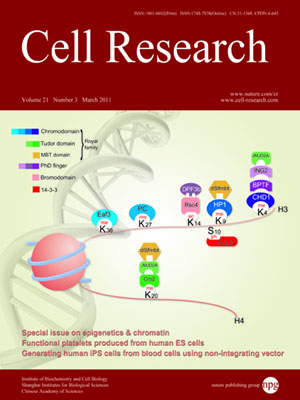
Volume 21, No 3, Mar 2011
ISSN: 1001-0602
EISSN: 1748-7838 2018
impact factor 17.848*
(Clarivate Analytics, 2019)
Volume 21 Issue 3, March 2011: 442-465
REVIEWS
Regulation and function of DNA methylation in plants and animals
Xin-Jian He1, Taiping Chen2 and Jian-Kang Zhu3,4
1National Institute of Biological Sciences, Beijing 102206, China
2Developmental and Molecular Pathways, Novartis Institutes for BioMedical Research, 100 Technology Square, Cambridge, MA 02139, USA
3Plant Stress Genomics Research Center, 4700 King Abdullah University of Science and Technology, Thuwal 23955-6900, Kingdom of Saudi Arabia
4Horticulture and Landscape Architecture Department, Purdue University, West Lafayette, IN 47907, USA
Correspondence: Xin-Jian He, Taiping Chen,(hexinjian@nibs.ac.cn; taiping.chen@novartis.com)
DNA methylation is an important epigenetic mark involved in diverse biological processes. In plants, DNA methylation can be established through the RNA-directed DNA methylation pathway, an RNA interference pathway for transcriptional gene silencing (TGS), which requires 24-nt small interfering RNAs. In mammals, de novo DNA methylation occurs primarily at two developmental stages: during early embryogenesis and during gametogenesis. While it is not clear whether establishment of DNA methylation patterns in mammals involves RNA interference in general, de novo DNA methylation and suppression of transposons in germ cells require 24-32-nt piwi-interacting small RNAs. DNA methylation status is dynamically regulated by DNA methylation and demethylation reactions. In plants, active DNA demethylation relies on the repressor of silencing 1 family of bifunctional DNA glycosylases, which remove the 5-methylcytosine base and then cleave the DNA backbone at the abasic site, initiating a base excision repair (BER) pathway. In animals, multiple mechanisms of active DNA demethylation have been proposed, including a deaminase- and DNA glycosylase-initiated BER pathway. New information concerning the effects of various histone modifications on the establishment and maintenance of DNA methylation has broadened our understanding of the regulation of DNA methylation. The function of DNA methylation in plants and animals is also discussed in this review.
Cell Research (2011) 21:442-465. doi:10.1038/cr.2011.23; published online 15 February 2011
FULL TEXT | PDF
Browse 2392


